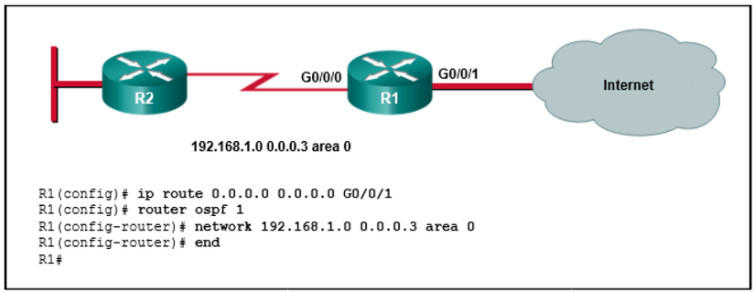1. What are two characteristics of OSPF areas? (Choose two.)
- Area 0 is called the backbone area.
- All OSPF networks require the use of multiple areas.
- OSPF areas create a three-layer hierarchical design.
- All OSPF areas must be directly connected to Area 0.
- Single area OSPF networks must be configured in Area 1.
- Each OSPF area must be configured with a loopback interface.
2. Which statement is true about OSPF DR and BDR elections?
- A new DR/BDR election occurs each time a new OSPF neighbor is added.
- The router with the highest OSPF priority setting wins the election for DR.
- The default priority value for a router connected to a multiaccess network is 0.
- The router with the highest MAC address is elected as the DR when the default priority values are used.
3. Which OSPF network type requires the election of a DR/BDR?
- broadcast
- point-to-point
- point-to-multipoint
- point-to-multipoint nonbroadcast
4. Which two Layer 2 multicast addresses are used for Layer 2 frames carrying OSPF messages? (Choose two.)
- 01:00:5E:00:00:06
- 01:00:5E:00:00:05
- 01:00:5E:00:00:0A
- 01:00:5E:00:00:02
- 01:00:5E:00:00:0F
5. Which OSPF neighbor state indicates that bidirectional communication has been established prior to LSDB synchronization?
- Init
- 2-Way
- Loading
- Full
6. A router with two LAN interfaces, two WAN interfaces, and one configured loopback interface is operating with OSPF as its routing protocol. What does the router OSPF process use to assign the router ID?
- the IP address of the interface that is configured with priority 0
- the OSPF area ID that is configured on the interface with the highest IP address
- the loopback interface IP address
- the highest IP address on the LAN interfaces
- the highest IP address that is configured on the WAN interfaces
7. Which IP protocol number is reserved for OSPF by the IANA?
- 6
- 88
- 89
- 112
8. Refer to the exhibit. R1 is configured properly for a single area OSPF, and R2 has been recently installed in the network. Which set of commands is required to configure a single area OSPF for the networks that are connected to R2?

- R2(config)# router ospf 1
R2(config-router)# network 192.168.2.0 0.0.0.255 area 0
R2(config-router)# network 10.1.1.0 0.0.0.3 area 0 - R2(config)# router ospf 1
R2(config-router)# network 192.168.2.0 0.0.0.255 area 0
R2(config)# router ospf 2
R2(config-router)# network 10.1.1.0 0.0.0.3 area 0 - R2(config)# router ospf 1
R2(config-router)# network 192.168.2.0 0.0.0.255 area 0
R2(config-router)# network 10.1.1.0 0.0.0.3 area 1 - R2(config)# router ospf 1
R2(config-router)# network 192.168.2.0 0.0.0.255 area 0
R2(config-router)# network 10.0.0.0 0.0.0.3 area 1
9. A network administrator is implementing OSPF in a portion of the network and must ensure that only specific routes are advertised via OSPF. Which network statement would configure the OSPF process for networks 192.168.4.0, 192.168.5.0, 192.168.6.0, and 192.168.7.0, now located in the backbone area, and inject them into the OSPF domain?
- r1(config-router)# network 192.168.4.0 0.0.3.255 area 0
- r1(config-router)# network 192.168.4.0 0.0.3.255 area 1
- r1(config-router)# network 192.168.4.0 0.0.15.255 area 1
- r1(config-router)# network 192.168.0.0 0.0.3.255 area 0
- r1(config-router)# network 192.168.0.0 0.0.15.255 area 1
- r1(config-router)# network 192.168.4.0 0.0.15.255 area 0
10. How does OSPF exchange routing updates when the passive-interface command is applied?
- OSPF forms neighbor adjacencies on that interface.
- The OSPF interface enters an active state.
- OSPF stops sending routing updates out that interface.
- OSPF only receives routing updates on that interface.
- OSPF neither sends nor receives routing updates through that interface.
11. Refer to the exhibit. An administrator has entered the commands shown on R1. However, the default route is not propagating to other OSPF routers. What configuration would likely correct this problem?

- Change the administrative distance on the static route to less than that of OSPF.
- Issue the
default-information originatecommand. - Issue the
redistribute staticcommand. - Use the
networkcommand to put network 0.0.0.0/0 into area 0.
12. What is the OSPF link cost of a Gigabit Ethernet interface if the reference bandwidth is configured as 10000 Mbps?
- 1
- 10
- 100
- 1000
“Do I Know This Already?” Quiz Answers:
1. OSPF uses the protocol number ___________ for its inter-router communication.
- 87
- 88
- 89
- 90
2. OSPF uses ___________ packet types for inter-router communication.
- three
- four
- five
- six
- seven
3. What destination addresses does OSPF use, when feasible? (Choose two.)
- IP address 224.0.0.5
- IP address 224.0.0.10
- IP address 224.0.0.8
- MAC address 01:00:5E:00:00:05
- MAC address 01:00:5E:00:00:0A
4. True or false: OSPF is only enabled on a router interface by using the command network ip-address wildcard-mask area area-id under the OSPF router process.
- True
- False
5. True or false: The OSPF process ID must match for routers to establish a neighbor adjacency.
- True
- False
6. True or false: A default route advertised with the command default informationoriginate in OSPF will always appear as an OSPF inter-area route.
- True
- False
7. True or false: The router with the highest IP address is the designated router when using a serial point-to-point link.
- True
- False
8. OSPF automatically assigns a link cost to an interface based on a reference bandwidth of ___________.
- 100 Mbps
- 1 Gbps
- 10 Gbps
- 40 Gbps
9. What command is configured to prevent a router from becoming the designated router for a network segment?
- The interface command ip ospf priority 0
- The interface command ip ospf priority 255
- The command dr-disable interface-id under the OSPF process
- The command passive interface interface-id under the OSPF process
- The command dr-priority interface-id 255 under the OSPF process
10. What is the advertised network for the loopback interface with IP address 10.123.4.1/30?
- 10.123.4.1/24
- 10.123.4.0/30
- 10.123.4.1/32
- 10.123.4.0/24
